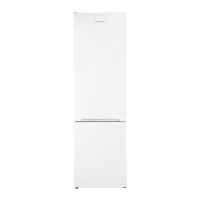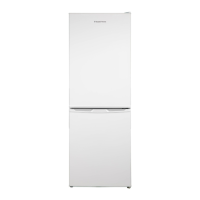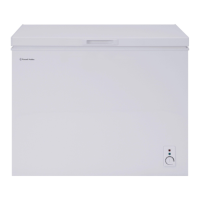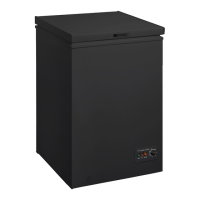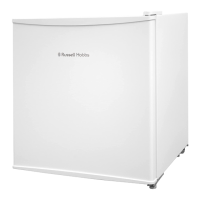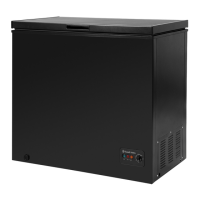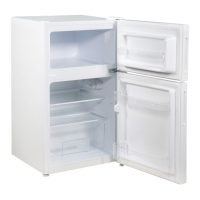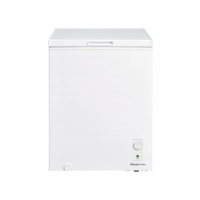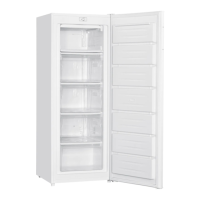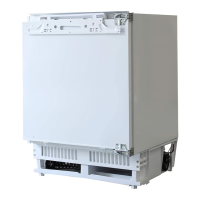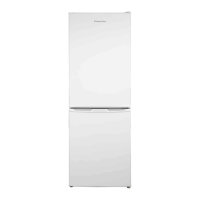
Do you have a question about the Russell Hobbs RH180FFFF55 and is the answer not in the manual?
| Type | Freestanding Freezer |
|---|---|
| Energy Rating | F |
| Weight | 31 kg |
| Freestanding Freezer | Yes |
| Energy Efficiency Class | F |
| Colour | White |
| Defrost Type | Manual |
Ensure appliance is plugged into an earthed socket for safety.
Verify your electricity supply voltage matches the appliance's rating plate (220-240V AC; 50Hz).
Guidelines for appliance use by children and impaired persons, with safety warnings.
Do not store explosive or flammable materials inside the appliance for safety reasons.
Follow instructions to avoid food contamination, especially regarding door opening and cleaning.
Ensure plugs are not damaged and cables are handled carefully to prevent electric shock.
Proper techniques for lifting and moving the heavy appliance to prevent injury or damage.
Proper placement away from heat, sunlight, and with adequate ventilation and clearances.
Use adjustable feet to ensure the appliance is level and stable for optimal operation.
Warning about flammable materials in refrigerant pipes and compressor; keep away from fire sources.
Clean the interior and remove transit materials before the first use.
Allow appliance to stand for 3 hours after positioning before plugging in to settle coolant.
Set thermostat between '3' and '4' after settling, then switch on the appliance.
Diagram identifying all parts, including thermostat, shelves, drawers, and external features.
Check all listed parts are present before proceeding with installation.
Allow appliance to stand for a minimum of 3 hours before plugging into the mains.
Using the temperature control dial to regulate internal temperatures and recommended settings.
Do not open the door for 4 hours after plugging in to allow appliance to reach standard operating temperature.
Fridge compartment: 0-4°C. Freezer compartment: -18°C to -25°C.
Tilt appliance safely (max 45°, min 2 people) and gather required tools for door reversal.
Steps to remove the door by detaching hinges and securing components.
Procedure for removing the middle hinge and transferring screw cap covers.
Placing the freezer door back onto the bottom hinge and aligning the middle hinge.
Ensure freezer door is horizontally and vertically aligned for proper sealing before final tightening.
Placing the fridge door back on the middle hinge and aligning it for proper sealing.
Warning: Light source must only be replaced by a qualified engineer.
Instructions for safely opening the cover, removing, and replacing the LED bulb.
Guidance on storing various foods in different refrigerator compartments for optimal freshness.
Tips for storing fresh food, including using airtight containers and appropriate packaging.
Tips on locating the appliance in a cool, well-ventilated area away from heat sources.
Minimizing door openings and maintaining clean door seals for energy efficiency.
Advice on keeping the freezer door closed and handling food after a power outage.
Steps for cleaning the appliance interior using mild solutions and avoiding excessive water.
Washing the exterior and cleaning the rear components for performance maintenance.
Instructions for preparing the appliance for periods of non-use, including cleaning and ventilation.
Information that the appliance is frost-free and defrosting is rarely needed.
Detailed steps if defrosting becomes necessary, including unplugging and water collection.
Critical warnings against using sharp metal tools or electrical heaters during defrosting.
Diagnostic steps for when the fridge/freezer fails to operate, checking power and connections.
Solutions for when the appliance is too warm or too cold, involving settings and environment.
Identifying and resolving sources of unpleasant smells within the appliance.
Troubleshooting steps for doors not closing properly and understanding unusual operating noises.
Mandatory earthing and confirmation of correct voltage (220-240V) and frequency (50Hz).
Correctly wiring the appliance's plug for UK sockets, matching wire colours to terminals.
Details on the 12-month guarantee, proof of purchase, and how to make a claim.
Understanding the terms and conditions, including what is and isn't covered by the guarantee.
Key specifications including model number, rated voltage, capacity, and external dimensions.
Information on energy consumption, storage volumes, and climate class suitability.
A blank space provided for users to record personal notes or observations.
